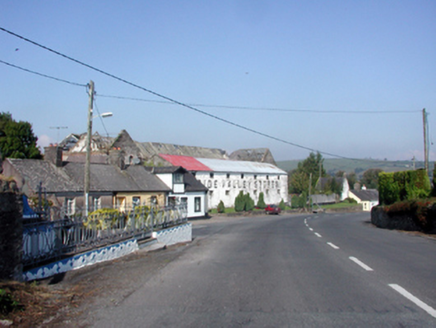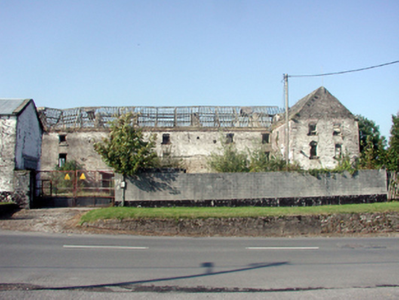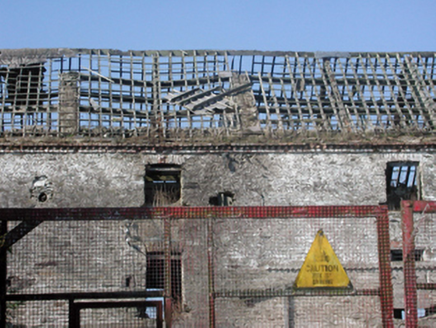Survey Data
Reg No
22818050
Rating
Regional
Categories of Special Interest
Architectural, Historical, Social
Previous Name
Tallow Barrack
Original Use
Barracks
Historical Use
Store/warehouse
Date
1747 - 1752
Coordinates
199527, 93072
Date Recorded
01/10/2003
Date Updated
--/--/--
Description
Detached eleven-bay three-storey barrack, extant 1752, on a U-shaped plan with two-bay three-storey gabled projecting end bays. Vacant, 1819; 1824. Adapted to alternative use, 1847. In alternative use, 1904. Occupied, 1920-2. In alternative use, 1923. Now in ruins. Hipped slate roof on a U-shaped plan on collared timber construction remodelled as pitched (gable-ended) slate roof on a U-shaped plan, clay ridge tiles, and no rainwater goods surviving on chevron- or saw tooth-detailed red brick header bond cornice. Limewashed walls with remains of slate hung surface finish. Square-headed window openings in camber-headed recesses with limewashed red brick voussoirs framing remains of timber sash windows having part exposed sash boxes. Interior in ruins. Set back from street in overgrown grounds.
Appraisal
A barrack erected to designs attributed to George Ensor (1724-1803) of Dublin (IAA Acc.2008/44) representing an important component of the eighteenth-century built heritage of County Waterford with the architectural value of the composition, one recalling the Ensor-built Loughrea Barrack in County Galway (Military Archives IE/MA/MPD/ad134729-006), confirmed by such attributes as the symmetrical "U"-shaped footprint; the disproportionate bias of solid to void in the massing compounded by the very slight diminishing in scale of the widely spaced openings on each floor; and the high pitched roof. Although reduced to ruins following a prolonged period of neglect in the later twentieth century, the form and massing survive intact together with interesting remnants of the original fabric, including a partial slate hung surface finish. NOTE: The barracks was vacated following the Napoleonic Wars (1803-15) and letters discussing its sale (1819; 1824) are included in correspondence between William George Spencer Cavendish (1790-1858), sixth Duke of Devonshire, and his agent Colonel William Samuel Currey (----) (National Archives of Ireland MS 43,545/11 and MS 43,545/19). The barracks knew several periods of reinvention over the course of the nineteenth century and it was requisitioned as an auxiliary workhouse by the Board of Guardians of the Lismore Poor Law Union in May 1847: William Hanan (d. 1887) is recorded as the Medical Officer of Tallow Dispensary and Auxiliary Workhouse and formerly the Physician of Tallow Fever Hospital (The Medical Directory for Ireland 1852, 51). The barracks was subsequently adapted as a corn store where 'each year [Mr. Cunningham] sold about 4,000 bags of corn at £1 each' (Walsh in The Schools' Collection 0638, 279). The barracks briefly returned to military use during "The Troubles" (1919-23) when it was occupied successively by the British Army, the Irish Republican Army and the Irish Free State Army: a claim was subsequently lodged by the Lismore Castle Estate 'for damages to the property' (Waterford County Archives IE/WCA/PP/LISM/515).





